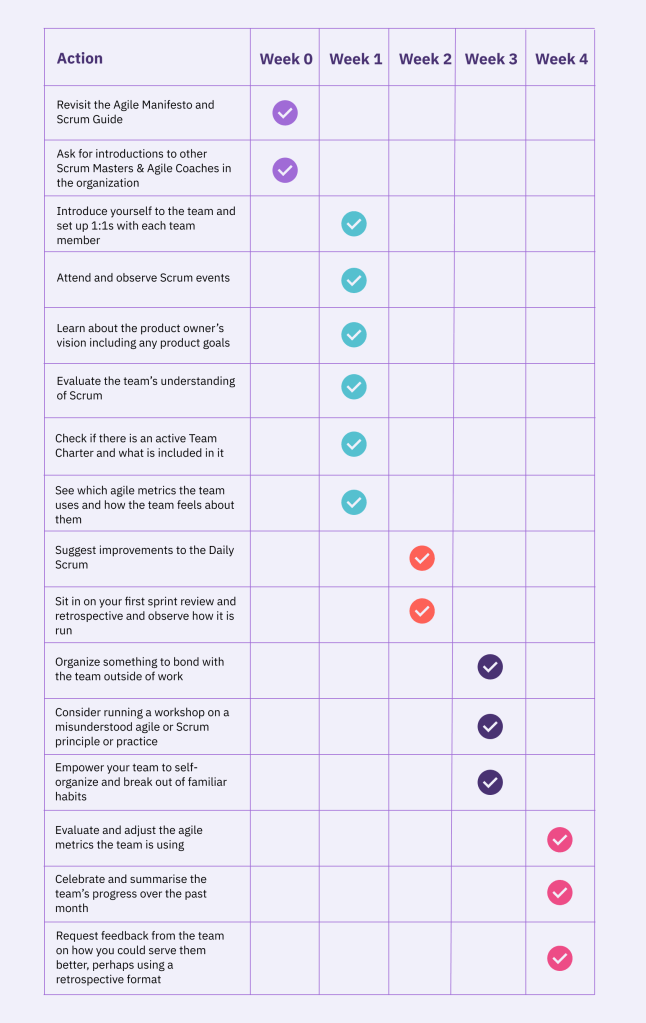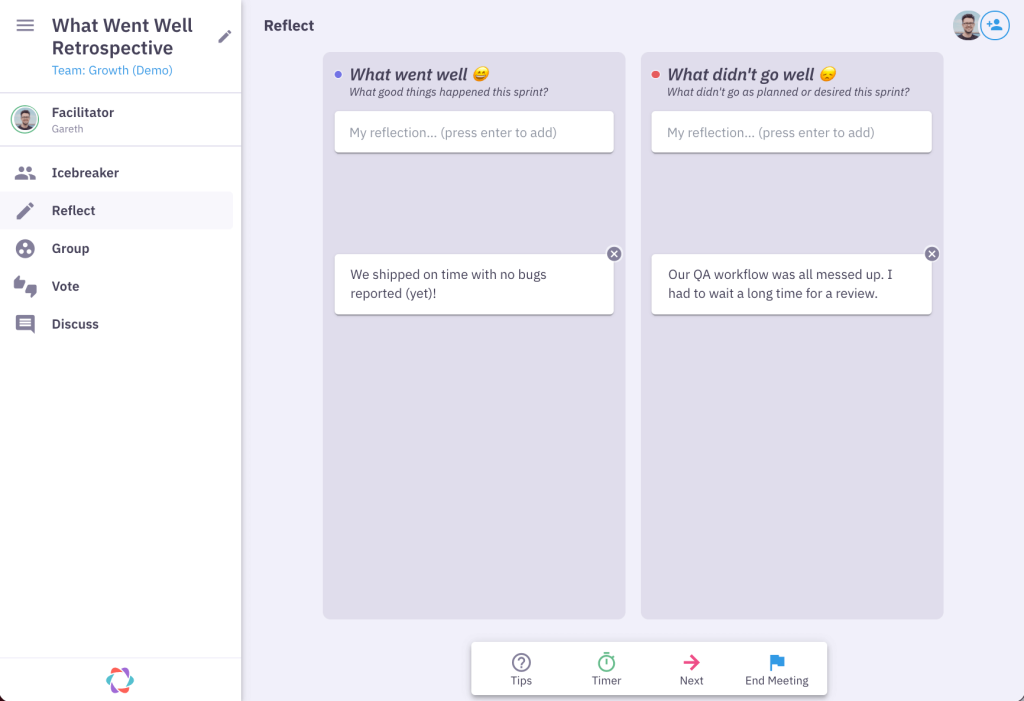How to Succeed as Scrum Master with a New Team + Checklist

Congratulations on landing your dream job as Scrum Master at a new company. You’re excited… and nervous. You’re inheriting a new team with old habits you might need to help them overcome.
How will the developers respond to your arrival? Can you quickly establish rapport with the Product Owner? Is it possible to create an instant connection?
Your first 30 days on the job are crucial for forging a strong bond and effective working relationship with your team. In this guide, we’ll help you manage the delicate dance of building trust and rapport while slowly but steadily bringing about change that delivers agile results.
📌 For the sake of simplicity, we’ve written this guide on the assumption that teams are running two-week sprints, and you’re hopping on board at the start of the first sprint. Timings don’t always align, so feel free to adapt the learnings here to your case.

Week 0: Prepare before you begin (especially if you’re a first-time Scrum Master)
Whether you got your Scrum certifications last week, last year, or never, preparing for a new assignment with a refresher of the basics is always a good idea.
Resources and fundamentals you might want to revisit before starting your new role:
- The five Scrum values: Commitment, courage, focus, openness, and respect.
- Scrum roles and their responsibilities: Product Owner, Scrum Master, and Developers.
- The five Scrum events: Sprint Planning, Daily Scrum, Sprint Review, Sprint Retrospective, and the Sprint.
Also take time to study the team’s history and documentation. Review existing team metrics and project artifacts to get a sense of the team’s strengths, weaknesses, and opportunities for improvement.
Building relationships with all team members, including the Product Owner (PO), developers, and any other on-staff Agile Coaches, is essential in your new role. Before your first official meeting with the entire Scrum team, consider scheduling informal one-on-one meetings with each team member to learn their perspectives on the team’s performance, challenges, and successes.
During these conversations, ask open-ended questions to understand each individual’s role and how they contribute to the team’s work. These talks will help you identify how to support each person.
Week 1: Listen and observe
The first week is crucial for your later success because first impressions matter. Follow these steps to lay a strong foundation and build trust:
Get to know your team
Introduce yourself to the team, share your background, and express your enthusiasm for working together. Have casual conversations with team members to learn about their roles, interests, and aspirations. Active listening and genuine interest are the magic words here for building rapport.
Observe and assess the team’s Scrum practices
Observe how the team currently works before suggesting any changes! Here are some suggestions of what to pay attention to:
- Attend Scrum events that take place early in the Sprint, such as Sprint Planning and Daily Standups to understand the team’s current processes and how they collaborate.
- Prioritize observation over action in these first meetings and avoid making premature suggestions or changes.
- See how well the team adheres to Scrum principles, values, and practices. Also, see if the group has a team charter and how they use it.
- Look for potential impediments, communication gaps, or workflow inefficiencies.
- Observe how open or closed communication is in meetings to get a read on the current level of psychological safety in the team.
- Evaluate the team’s understanding and adoption of their roles and responsibilities.
- Consider the effectiveness of the team’s artifacts, such as the product backlog, sprint backlog, and user stories.
- See which agile metrics the team uses, how the team feels about them, and whether they’re helping the team reach their sprint goals and product goals and improve performance.
Support the Product Owner’s vision
The Product Owner is responsible for aligning the team around a shared vision and goals. As a Scrum Master, your role is to ensure the team understands and embraces these priorities. Encourage team members to ask questions and seek clarification when needed, and promote transparency by reminding the Product Owner to explain the reasons for their decisions and priorities.
Week 2: Start facilitating and coaching
In your second week, focus on refining Scrum events and promoting continuous improvement.
Tweak the Daily Scrum
Since the Daily Standup happens every day of a Sprint, any improvements you make to this event compound. Ensure that everyone has an opportunity to share updates, ask questions, and voice concerns. To identify obstacles, pay attention to recurring issues, team member feedback, and potential bottlenecks.
Based on the trust you’ve built during the first week, now is also a perfect moment to introduce a new tool or approach, like Parabol’s Daily Standup tool, which makes it easy for team members to give and see quick updates throughout the day instead of having to gather for long video-based updates in real time.
Sweat your first Sprint Review
Managing stakeholder expectations is essential, especially for your first Sprint Review.
Before the event, talk to stakeholders to set their expectations for the session. For example, explain that the review will focus on the team’s progress during this sprint and what they might work on next, not long-term plans.
Find out which questions stakeholders may have for the team, and share this information with the group in advance so they can prepare themselves.
Make sure you’re up to date on the team’s progress. Become aware of obstacles, deferred items, and other issues so you can anticipate questions and facilitate a productive discussion.
Structure the Sprint Retrospective
For your first retrospective, consider introducing Parabol’s retrospective tool, so you can follow a structured format that promotes participation from everyone. For less mature teams, Parabol acts as training wheels for retrospectives, guiding them through each meeting stage in a structured way.
With Parabol, you can open the virtual retro at the beginning of your second week. Doing so gives team members several days to add their ideas, comments, and concerns. Once it’s time for the retro, our tool guides you through an easy and collaborative process for topic organization, prioritization, and discussion.
Matt Adesanya, Engineering Manager at Mollie“Parabol made me a master of retros! It’s helped our whole team learn how to lead effective retrospectives which has made our retros more valuable.”
This first retrospective may also be perfect for introducing or revising the team charter. This document states why the team exists and what’s required to fulfill its purpose. It explains who the team members are, their roles, goals, and what resources and constraints they’ll work with. Setting a new team charter as you come on board can provide a useful refresher and help people more strongly commit to how they work together.
Don’t forget to include a request for feedback on your performance as Scrum Master in the retro, demonstrating your commitment to continuous improvement and transparency.
Week 3: Accelerate your team’s performance
In the third week, focus on enhancing your team’s performance through bonding, a targeted workshop, and one-on-one coaching.
Bond outside of work
The end of your second week or the start of the third is a good moment for an informal gathering so team members can connect and interact in a relaxed setting. Co-located teams can have lunch, dinner, or drinks together–remote teams can play online games like Codenames (word association), Tabletop Simulator (3D online board games), or Werewolf (video conference game).
You could also try running a retrospective-themed game to teach an agile concept or focus on process improvement.
Organize a workshop on a misunderstood agile principle or practice
By now, you’ll have identified the aspects of Scrum or Agile your team struggles with. Use your observations to design a workshop addressing those challenges. Even better, give your team a choice of topics and let them pick the one they would benefit most from.
For example, many teams need help with agile estimation. They spend too much time on it or don’t get value from the few techniques they’re familiar with. A workshop can show the workings and benefits of estimation methods like t-shirt sizing, sprint poker, and Weighted Shortest Job First (WSFJ). Equipped with this knowledge, the team can start using these approaches to improve and accelerate their estimation efforts.
Other commonly misunderstood topics include story points, velocity, and the purpose of each Scrum event.
Give your team confidence to self-organize
Create an atmosphere where team members feel confident expressing opinions, suggesting solutions, and taking calculated risks. An effective way to do this is by having one-on-one coaching sessions in which you help team members think through challenges and build their confidence.
Scrum emphasizes the importance of self-reliant, cross-functional teams that possess all the necessary skills to complete their work. You can help the team by training or pairing people with different skills. Team members can also teach each other through skill-sharing sessions or a mentorship program within the group.
Week 4: Measure, celebrate, and reflect on your progress
Assess how you measure progress and reflect on what the team has achieved in your first month working together. Here are several suggested actions that can work well in your fourth week:
Evaluate and adjust the agile metrics you use
Now that you’ve worked with the team for a few weeks, assess the usefulness of the agile metrics they’re using. Do the numbers provide insights that help the team with their current goals and challenges? If not, choose one or two new agile metrics to focus on. For example, monitoring team happiness can be helpful during a team’s first month, while velocity only stabilizes after a few sprints and isn’t the best metric when you start working together.
Don’t forget to also ask team members how they feel about metrics. If a metric is causing undue stress and damaging morale, consider getting rid of it and replacing it with something that people feel driven towards.
Celebrate and showcase the team’s progress
Highlight achievements within the group by going for another lunch, dinner, drink, or team-building activity. Also, keep stakeholders informed, and encourage them to compliment the team if they’re happy with their work.
Reflect on your first month as a Scrum Master
Assess your personal growth and development. Identify areas where you can improve your skills and knowledge to support the team better. Get their feedback and consider participating in training, meetups, or communities to enhance your abilities (see the resources section later in this article). You can even hold an evaluation of your performance through a dedicated retrospective.
Overcoming common Scrum Master challenges
If anyone ever said being a Scrum Master is easy, they’re wrong. A successful Scrum Master is a jack of all trades – coach, change agent, teacher, therapist, and student are just some of the hats you must wear. And no matter how much Scrum theory you read, the only path to mastery is putting it into practice by making mistakes and learning from them.
Here’s an overview of common challenges Scrum Masters face with new teams and how to overcome them.
Handling questions and skepticism about the Scrum framework
Even seasoned Scrum Masters sometimes struggle with the vagueness and nuances of Scrum, especially in new work environments where coworkers bring up questions and challenges you haven’t heard before.
The Scrum Guide 2020 edition“The Scrum framework is purposefully incomplete, only defining the parts required to implement Scrum theory. Scrum is built upon by the collective intelligence of the people using it. Rather than provide people with detailed instructions, the rules of Scrum guide their relationships and interactions.”
There are only two ways to solve this problem, and you need to do both:
- Seek learning. Read books, connect with peers, take training courses.
- Keep putting in the miles. No matter how much you read or hear, you’ll learn most from being in the arena.
💡 To further expand your agile coaching capabilities, check out Agile Coaching 101: How to Get Started and 7 Roles to Master.
Mastering servant leadership
This challenge is common when transitioning from a traditional project manager role to Scrum Master. You’ll need a mindset shift – embracing the principles of servant leadership rather than the directive approach that characterizes project management, with its one-way communication and top-down decision-making.
Lyssa Adkins in Coaching Agile Teams“A project manager and an agile coach are not even as much alike as a house cat and a jaguar. They are simply not in the same family. A project manager plans and controls, supervising throughout. A coach guides. A project manager’s success equals the success of the project. An agile coach’s success equals the team’s continual improvement and their pursuit of high performance. The two are focused on completely different things and thus act completely differently.”
To make this shift, adopt these two habits:
- Cultivate active listening. Pay close attention to your team members’ thoughts, ideas, and concerns. This skill allows you to understand their needs better and give guidance instead of issuing orders or instructions.
- Encourage self-organization. Ask open-ended questions that empower team members to take ownership of their work. For example, rather than assigning tasks, ask, “Who feels they have the skills to tackle this task?” This approach fosters autonomy and strengthens the team’s ability to self-organize.
Managing internal resistance to Agile change
Resistance to Agile and Scrum practices is a significant challenge for Scrum Masters, especially when teams and organizations tend to fall back on their traditional ways of working. To overcome this resistance, consider these tactics:
- Educate and inspire. Host workshops or lunch-and-learn sessions that illustrate the benefits of Agile, showcasing real-world examples of successful adoption. These sessions focus on building understanding and enthusiasm for Agile practices.
- Promote open communication. Schedule regular meetings with the Product Owner, development team, and other stakeholders to discuss challenges, updates, and concerns about Agile.
- Leverage allies and data. Identify agile ambassadors within the organization, and collaborate with them to create a shared vision of Scrum adoption. Use data on the team’s performance and success stories to demonstrate the benefits of Scrum in quantifiable terms, reinforcing your case for change and improvement.
Balancing multiple roles
Many Scrum Masters juggle multiple roles within a team or organization, leading to conflicting responsibilities and priorities. Striking a balance requires practice, organization, and clear communication.
Begin by defining and prioritizing your tasks, ensuring your Scrum Master duties remain uncompromised. Establishing boundaries is key–they prevent one role from casting a shadow over the other.
Consider this practical approach: designate specific days or time blocks for each role. For instance, reserve Mondays and Tuesdays for your Scrum Master responsibilities and Wednesdays and Thursdays for your other commitments. This separation helps you stay focused.
Also, be transparent with team members and stakeholders about your multiple roles. Work together to manage expectations and ensure everyone understands your commitments and priorities.
Staying effective in remote or hybrid work environments
Managing Scrum practices in remote or distributed teams can present unique challenges, such as timezone differences, communication barriers, and limited face-to-face interactions.
Parabol offers solutions tailored to these issues, allowing you to hold several Scrum events async–partially or even entirely:
- You can make Daily Standups async without the risk of your team’s updates gathering dust in a Slack channel.
- Our Retrospectives can automatically include icebreaker questions, and we offer you the flexibility to spread the event over days.
- Sprint Poker is the most entertaining and effective way for remote teams to estimate user stories–you can play it async if you like.
Essential Scrum Master resources
As a Scrum Master with a new team, you need all the help you can get. Here’s an overview of books, communities, and tools that can help you further expand and improve your mastery of serving, coaching, and guiding the teams you work with.
Must-read books for Scrum Masters
Coaching Agile Teams by Lyssa Adkins offers an in-depth exploration of the agile coach’s role. It guides readers in adopting a new mindset to lead teams to extraordinary performance, covering essential topics like self-organizing high-performance teams, evolving leadership styles, and personal agile coaching journeys.
Scrum Mastery: From Good To Great Servant-Leadership by Geoff Watts goes into the qualities of exceptional Scrum Masters. The book provides guidance on enhancing team engagement, Scrum meetings, creativity, collaboration, and performance, offering practical advice on becoming a servant-leader who can inspire a Scrum team beyond just following rules.
Mastering Professional Scrum by Stephanie Ockerman and Simon Reindl is a helpful guide for improving your existing use of Scrum. The authors address common challenges, such as assessing current practices, delivering value with each Product Increment, and removing organizational agility impediments. This book benefits Scrum Masters, Development Team members, and Product Owners looking to refine their approach and deliver greater value.
Scrum Masters Reddit and other online communities
Online communities offer Scrum Masters valuable opportunities to connect, share knowledge, and learn. The Scrum Master Reddit community is an excellent platform for sharing challenges and best practices. Other options include LinkedIn groups, local Agile events, and Communities of Practice.
Scrum Master Communities of Practice are groups of professionals collaborating to develop their skills. You can find these communities within organizations or online. Well-known platforms like Scrum.org and Scrum Alliance host their own online Communities of Practice for global participation.
A daily checklist for Scrum Masters
There are countless things to remember, do, and keep track of as a new Scrum Master in your first 30 days with a team. Here’s a daily checklist you can run through during that period so you don’t forget anything critical.
1. Start your day with a plan:
☑️ Review your daily schedule and prioritize task
☑️ Identify team members who might need extra support or guidance
2. Facilitate the Daily Scrum:
☑️ Ensure the meeting is time-boxed to under 15 minutes
☑️ Make sure everyone shares updates, questions, and concerns
3. Observe and assess the team’s Scrum practices:
☑️ Take note of potential issues, communication gaps, or workflow inefficiencies
☑️ Evaluate the team’s adherence to Scrum principles, values, and practices
4. Support the Product Owner:
☑️ Check in for clarification on priorities and goals
☑️ Offer help with backlog refinement or stakeholder communication
5. Address external impediments:
☑️ Resolve technical issues or external dependencies
☑️ Communicate with stakeholders to address problematic behavior
6. Nurture a positive team culture:
☑️ Encourage open communication and collaboration
☑️ Recognize individual contributions and celebrate small wins
☑️ Promote a blame-free environment for discussing challenges
7. Practice servant leadership:
☑️ Schedule or hold one-on-ones with team members
☑️ Be accessible, empathetic, and offer guidance as needed
☑️ Support team members in resolving personal concerns or challenges
8. Reflect and adapt:
☑️ Reflect on your actions and decisions throughout the day
☑️ Assess yourself on the five Scrum values and choose one to focus on the next day
With this daily checklist in hand, you’ll never forget the essential responsibilities of your role as Scrum Master. You’ll set yourself up for long-term success with a team that consistently delivers value and continuously improves.
Useful Scrum Master templates and tools
Scrum Mastery is easier with the right tools and templates. Parabol offers several solutions to support you in this journey.
During planning poker, teams estimate the effort required for user stories or tasks by playing cards with different values from a customized deck. Parabol’s Sprint Poker tool simplifies this process for remote teams.

With Sprint Poker, all team members, including POs, developers, and Scrum Masters, have the same set of cards and look at the same user stories in real time. Votes remain anonymous until everyone has participated, preventing anchoring bias.
Our tool reveals your estimates once everyone has voted and can sync the results to Jira, GitHub, or GitLab for free.
Parabol retrospectives allow you to run virtual retros partially or fully async. You follow a structured process where the team can group and vote on topics to build a focused agenda.

Our tool allows you to add anonymous replies to retrospective prompts. You can then hold a structured conversation about your team’s top issues and create trackable action items that sync with Jira, GitHub, or GitLab.
Parabol offers over 35 pre-built retrospective templates—pick one and start running your next sprint retrospective in minutes.
Each template offers a specific theme or approach tailored to different retrospective objectives, like Start Stop Continue, Mad Sad Glad, and a Scrum Values retro. We also have seasonal formats, like Christmas, Midsummer, and Lunar New Year.
Run your synchronous or asynchronous daily standups directly within Parabol. Customize your prompts and see all team updates in one place.

As a Scrum Master in a new team, Parabol is the perfect way to get your team on track and learning positive behaviors for Scrum success.









